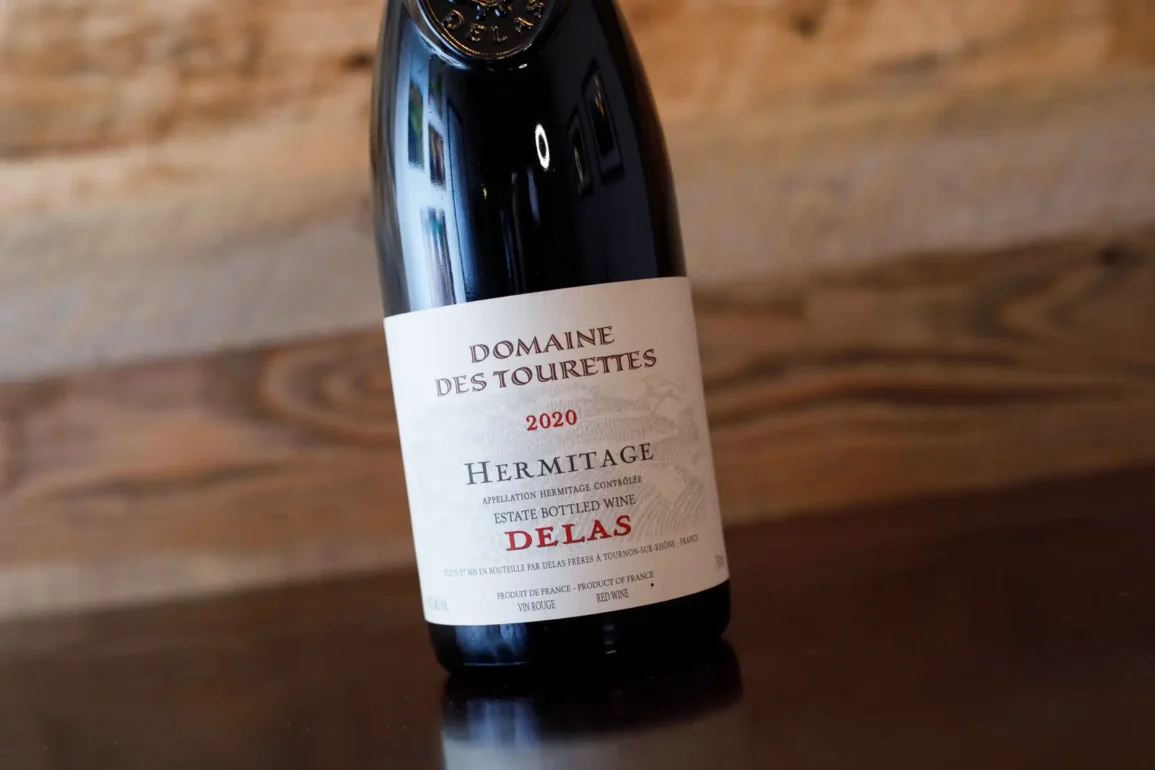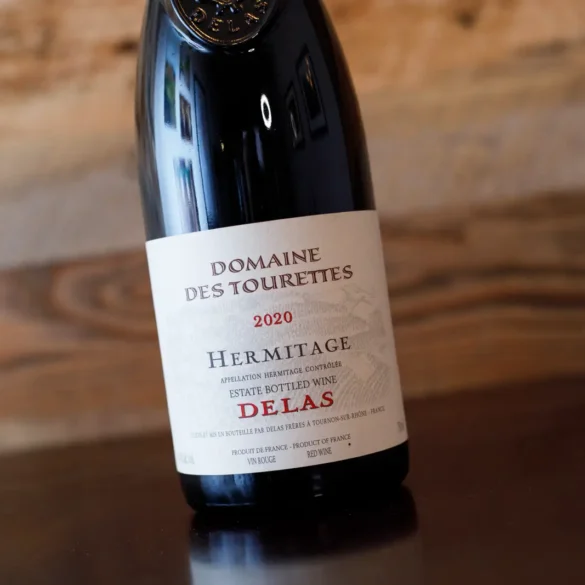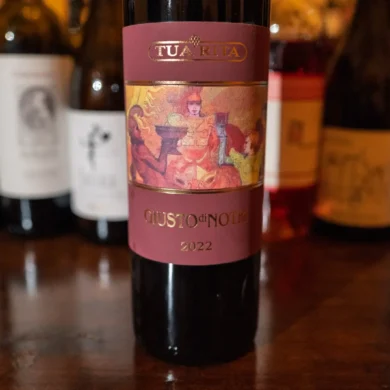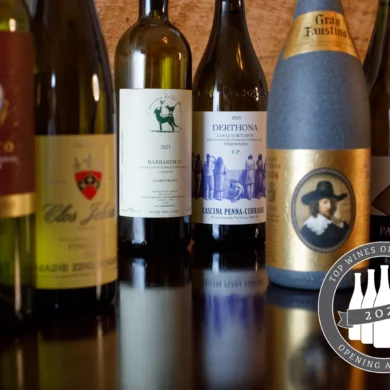The Hermitage AOC is one of France’s most sanctified terroirs. From this mighty hill overlooking a crook in the Rhône River comes what many believe is the benchmark expression of Syrah in the world. But Hermitage is also teeny, tiny: between 136 and 140 hectares of vines, depending on the estimate. There has never been much of it, so it has long come at a startling premium.
In wineries like Delas Frères, I find something that’s actually quite exciting: can a large-scale winery still give us a sense of intimacy from a top terroir?
But what has long kept Hermitage from feeling modern is that so much of this appellation is concentrated in the hands of the few. Half is held by two wineries: Maison M. Chapoutier and the local cooperative Cave de Tain-l’Hermitage (this being a cooperative, it is owned by many small landowners who contribute to one winery). Delas Frères, Maison Paul Jaboulet Aînè and Domaine Jean-Louis Chave combine to own a significant portion of the rest. With the exception of Domaine Jean-Louis Chave, these are fairly big wineries. Maison M. Chapoutier produces between 7 million and 10 million bottles per year while at the other end of the spectrum Paul Jaboulet Aîné makes a comparatively modest half-million bottles. Delas Frères, a hybrid négociant owned by Champagne Louis Roederer, produces around 1.7 million bottles.
I know, I know: that’s a lot of dry stats to start off this column. But it underscores the dilemma with Hermitage to an outsider like me who rarely taste it. For such a highly esteemed and intimate hill, the production of many of its wines would seem to be the opposite: done and conducted by big producers with a huge wine footprint. That explains why you don’t see a lot of sommeliers or geeky wine shops sharing bottles of Hermitage on Instagram: it doesn’t have the indie cache that so many of those feeds thrive on.
But is That Really a Problem?
I was recently sent a sample of Delas Freres’ 2020 “Domaine des Tourettes” Hermitage, and it made me ponder a few issues with this particular oddball appellation. First was whether the hype of Hermitage was backed up. Would I find a soaring expression of complexity and head-spinning detail? Or just another technically sound wine that checked all the boxes except personality?
Secondly, would I be able to open my mind a bit? Movie critics might geek out over an indie film, but they still have to review the latest Marvel film with the same diligence. As a wine writer, I am free from the wine critic’s demands of reviewing everything from within my specialty focus. Yet, that freedom does tend to make me gravitate to smaller, harder to find wines: in other words, where the good stories reside.
Yet I’ve come to grow a bit tired of always seeking the esoteric, and in wineries like Delas Frères, I find something that’s actually quite exciting: can a large-scale winery still give us a sense of intimacy from a top terroir?
And in the case of the 2020 “Domaine des Tourettes” Hermitage, they largely do. This wine reaffirmed my belief in improbable viticulture, a key concept in my new book. You simply cannot get past the toil of this hill, no matter how much capital your winery can raise. And that demands a certain discipline that leads to good wine.
The first thing I noticed with the 2020 was the wine’s heightened stature, which is a trait that puts Hermitage above all others. The fruit is bolder; the tertiary tones are many, but tightly coiled; the tannins are firmer. If Cornas were a person at eye-level, Hermitage would be a basketball player towering over you.
But what I found most appealing was the surprisingly simple pleasure of this wine. For all that structure, it was remarkably easy to drink. Five years into its life still feels too soon to survey its tones in totality, but I’ve got a job to do, and the wine made it easier on me by being simply delicious.
Again, you cannot ignore the toil of Hermitage, where the slopes can often be at a 50% gradient. These are some of France’s most inhospitable vineyards, and they require that all labor be done by hand. That doesn’t guarantee a fine wine, but time and time again, I see it ensuring some level of quality and care. You wouldn’t bother otherwise.
Note: this is not the current vintage, which would be the 2022. The wine is a spendy one (just over $100/bottle retail in the United States as of November 2025), but an affordable option when compared to other Hermitage.
2020 Delas Frères “Domaine des Tourettes” Hermitage
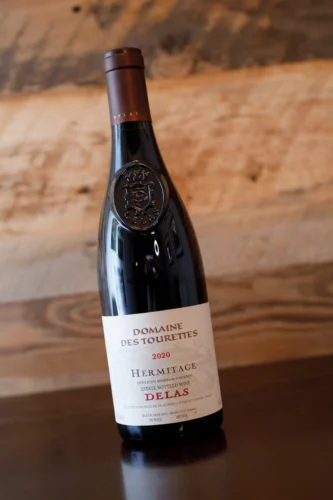 Hermitage AOC (Northern Rhône )
Hermitage AOC (Northern Rhône )
Grapes: Syrah (100%)
Alcohol: 14.5%
Food-friendliness: Selective
Value: As Expected
A beginner might like … looking for that black olive tapenade note that marks so many Northern Rhône Syrah. The 2020 “Domaine des Tourettes” is a text book example of this note.
A wine obsessive might like … to know that this wine is a blend of two substantial plots on the Hermitage hill: Les Bessards and Les Grandes Vignes. Both plots reside on the western side of Hermitage, with Les Grands Vignes accounting for 23% of the cuvée. Because of its higher elevation, Les Grands Vignes adds a linear quality to the wine. Delas also makes a single-vineyard wine from each parcel, which would make an interesting contrast for terroir nerds.
Note: This wine was provided as a sample. Learn more about my editorial policy.

